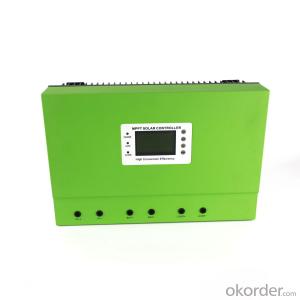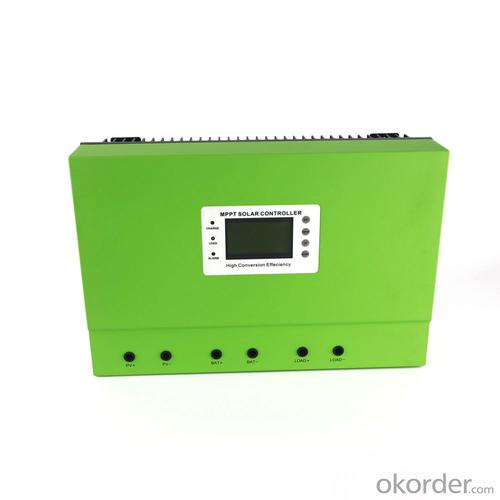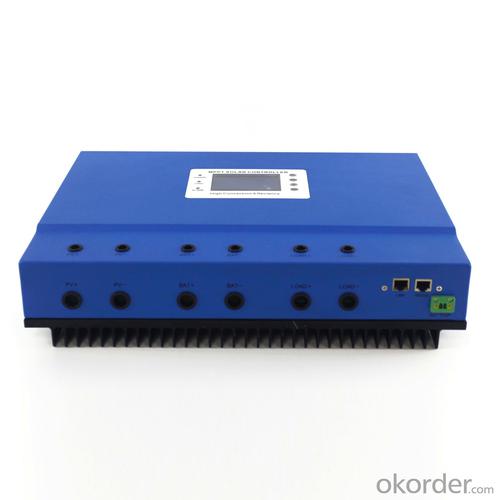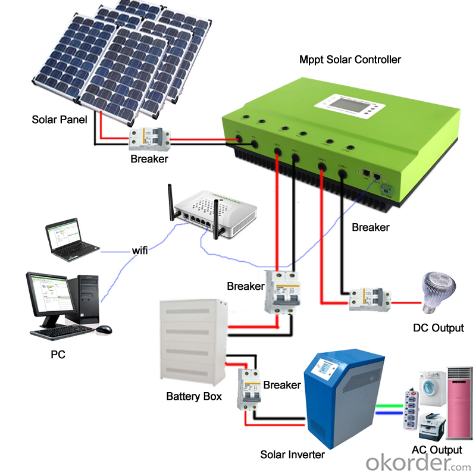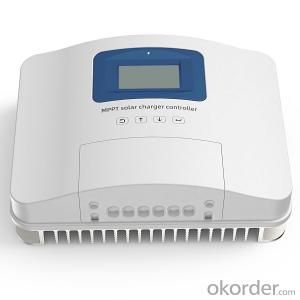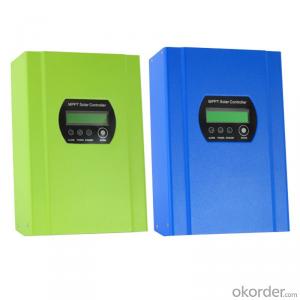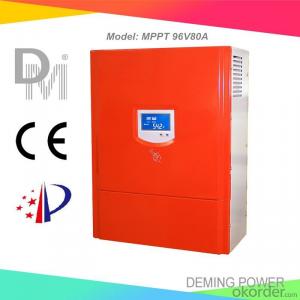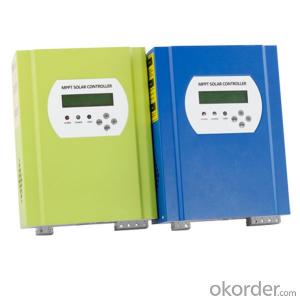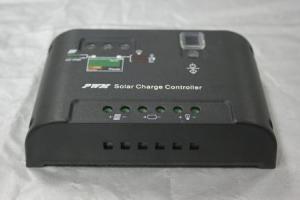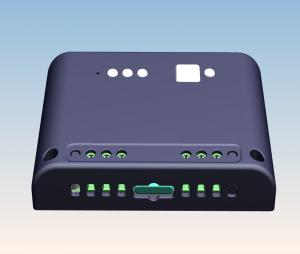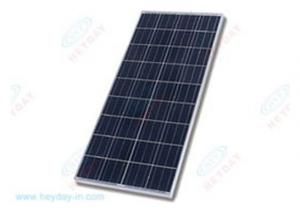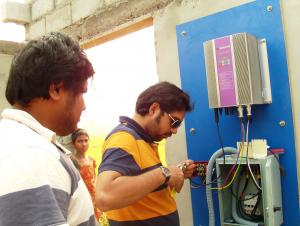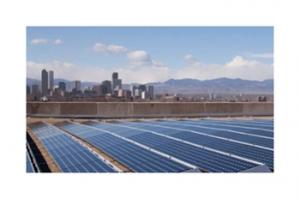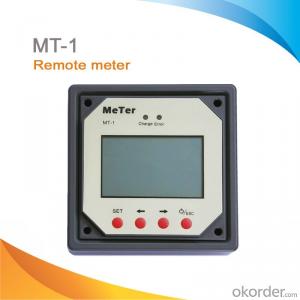Master 80A MPPT solar regulator, 12V 24V 36V 48V charge controller 4000W
- Loading Port:
- China main port
- Payment Terms:
- TT OR LC
- Min Order Qty:
- 10 unit
- Supply Capability:
- 9999 unit/month
OKorder Service Pledge
OKorder Financial Service
You Might Also Like
High efficient MPPT 48v 80a solar charger controller
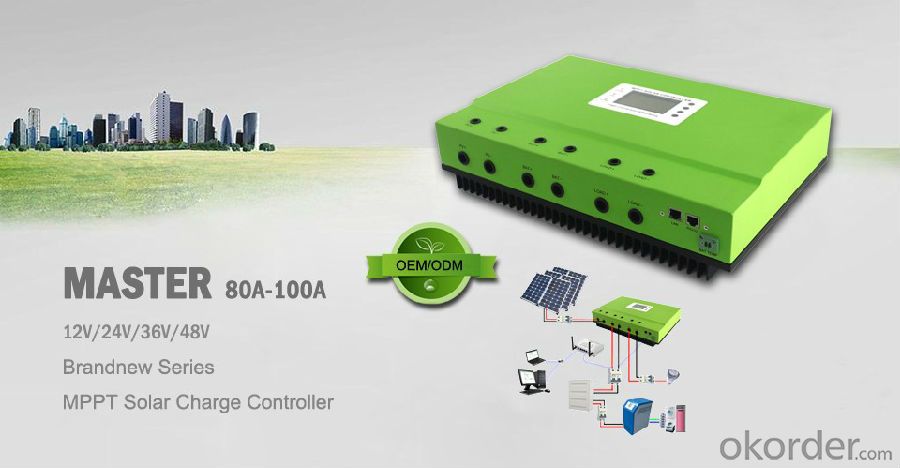
Products Advantages
1. MPPT charge mode,conversion efficiency up to 99%;
2. Maximum PV input is DC 150V;
3. Support all kind of batteries, non-normal type can be set on PC software;
4. Three stage charge mode: fast charge,constant charge,floating charge);
5. With temperature sensor;
6. Anderson connection port, avoide reverse connection;
7. RS232 and LAN communication port, free PC software;
8. Intelligent design,the device can be upgraded online;
9. The devices can suffer the temperature not less than 105°C;
10. Perfect protection:input lowvoltage,input overvoltage,input polarity reversal,
output over voltage,short-circuit over temperature;
11. Unlimited parallel;
12. 5 discharge mode;
13. LCD and LED show all kinds of parameter;
14. CE,ROHS,FCC certifications approved.The device also can support to pass the other certifications;
15. 2 years warranty and 3~10 years extended warranty service also can be provided.
Connection Diagram
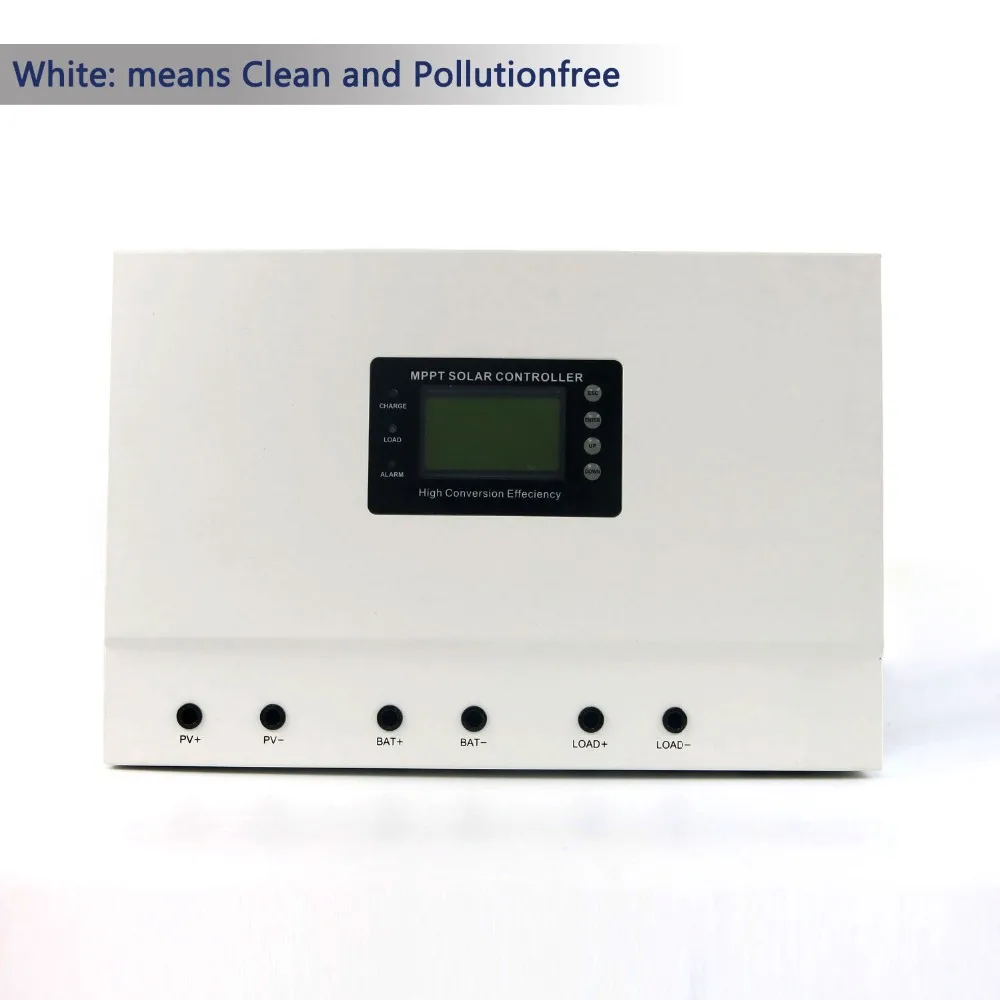
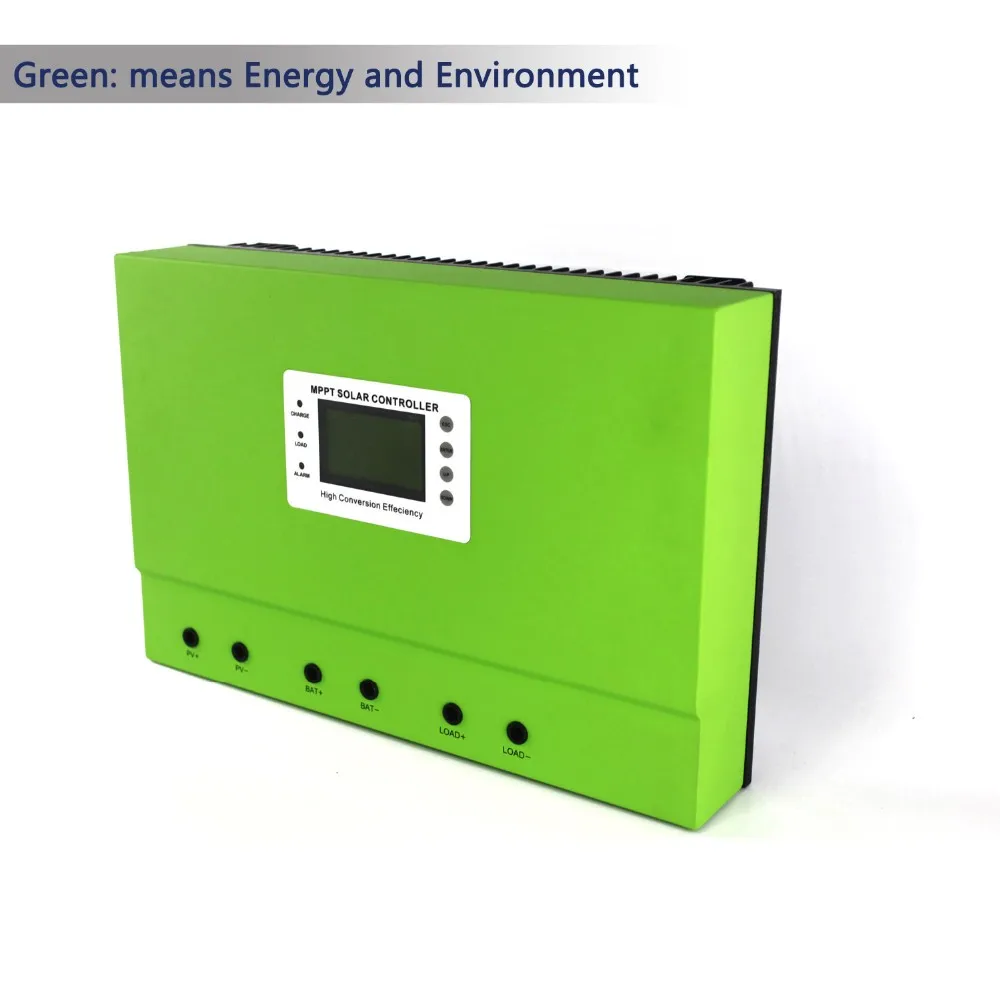

Upper PC Software
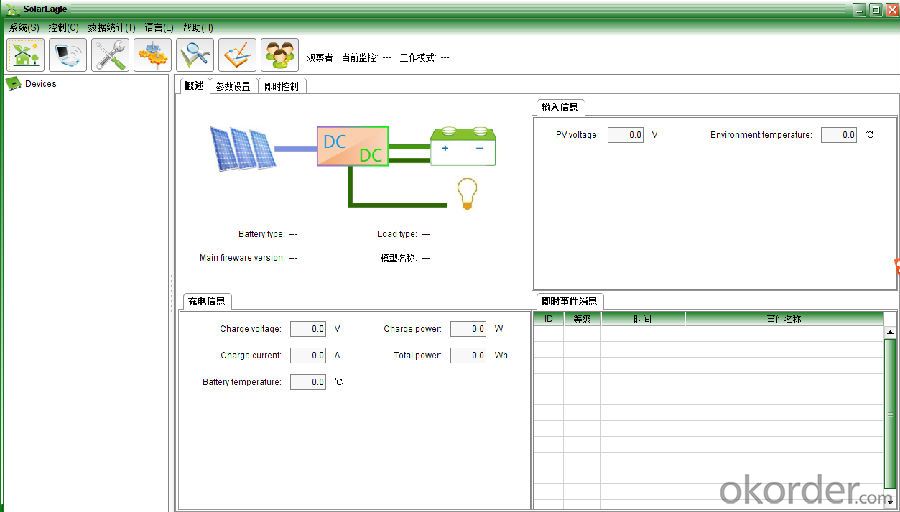
Test Software
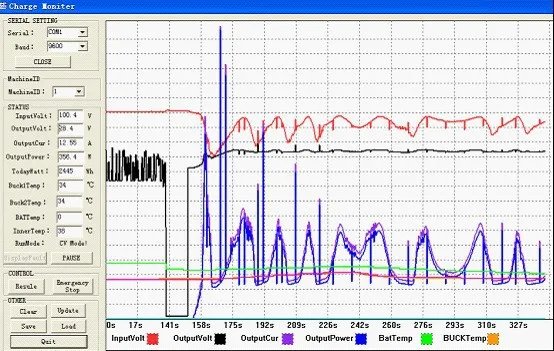
Parameter
MPPT controller Model: Master1-80A/100A Series | 80A | 100A | |
Charge Mode | MPPT(Maximum Power Point Tracking) | ||
Charge Method | 3 stages: fast charge(MPPT),constant voltage, floating charge | ||
System Type | DC12V/24V/36V/48V | Automatic recognition | |
Conversion Efficiency | DC12V/24V/36V/48V | 96.5% ~99% | |
PV Modules Utilization Rate | DC12V/24V/36V/48V | ≥99% | |
PV Input Characteristics | |||
MPPT Working Voltage and Range | 12V system | DC22V~DC150V | |
24V system | DC34V~DC150V | ||
36V system | DC50V~DC150V | ||
48V system | DC60V~DC150V | ||
Input Over voltage Protection Point | DC12V/24V/36V/48V | DC150V | |
Rate charge current | DC12V/24V/36V/48V | 80A | 100A |
Max. PV Power | 12V system | 960W | 1200W |
24V system | 1920W | 2400W | |
36V system | 2880W | 3600W | |
48V system | 3840W | 4800W | |
Charge characteristic | |||
Selectable Battery Types (Default type is GEL battery) | DC12V/24V/36V/48V | Sealed lead acid, vented Gel, NiCd battery (Other types of the batteries also can be defined) | |
Temperature Compensation | DC12V/24V/36V/48V | 14.2V-(The highest temperature-25℃)*0.3 | |
Discharge characteristic | |||
Setting Control | Controller or PC software | ||
Max discharge current | DC12V/24V/36V/48V | 100A | |
Output control mode | Double-time control, ON/OFF mode, PV voltage control, PV&Time control | ||
Physical | |||
Communication Port | RS232 and LAN | ||
Measurement D*W*H (mm) | 420*280*102 | ||
N.G(kg) | 7.5 | ||
G.N(kg) | 8.5 | ||
Color | Blue, Green, White (optional) or OEM | ||
Environment | |||
Humidity | 0~90%RH ( no condense) | ||
Altitude | 0~3000m | ||
Operating Temperature | -20℃ ~ +40℃ | ||
Storage Temperature | -40℃ ~ +75℃ | ||
Atmospheric Pressure | 70~106kPa | ||
Certifications |
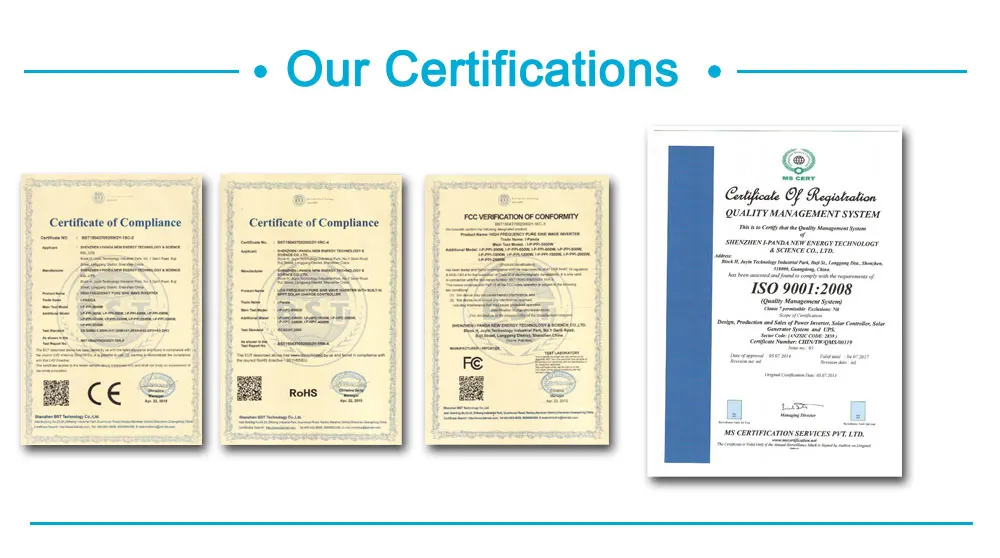
F&Q: |
Q1. How to ensure and monitor the products quality?
A1: We have established a perfect Quality Management System, In strict
accordance with ISO9001: 2008 quality system and ISO14001 environment system for quality assurance management;
Our ISO9001:2008 Quality System certificate encoding: CHIN/TW/QMS/00119;
Our ISO14001 Environment System certificate encoding: CHIN/TW/EMS/00028;
Q2. What is the warranty of products?
A2: The warranty period of different products are different; 5 years, 3 years, 2 years, 1 years; More details please refer to the product specification or manual; we will provide free life-long technical support ;
Q3. What is the difference between MPPT&PWM?
A3. MPPT charging mode, peak efficiency up to 99%, saving 30%~60% solar panel than traditional PWM controller.
- Q: Can a solar controller be used with a battery bank that is being charged from other sources (e.g., grid, generator)?
- Yes, a solar controller can be used with a battery bank that is being charged from other sources such as the grid or a generator. The solar controller will regulate the charging process and ensure that the battery bank is charged safely and efficiently, regardless of the source of power.
- Q: What is the maximum number of solar panels a solar controller can handle?
- The maximum number of solar panels a solar controller can handle depends on the specific model and its specifications. Different solar controllers have different capacity limits, which are typically measured in terms of the maximum input voltage and current they can handle. It is important to consult the manufacturer's specifications or user manual to determine the exact maximum number of solar panels that a specific solar controller can handle.
- Q: Can a solar controller be used for off-grid cabins or RVs?
- Yes, a solar controller can be used for off-grid cabins or RVs. A solar controller is an essential component of a solar power system, regulating the flow of electricity from the solar panels to the battery bank. It ensures that the batteries are charged efficiently and protects them from overcharging or damage. Whether it's an off-grid cabin or an RV, a solar controller helps optimize the use of solar energy and ensures a reliable and sustainable power supply.
- Q: Can a solar controller be used with solar-powered indoor recreational facilities?
- Solar-powered indoor recreational facilities can make use of a solar controller. This component is essential in a solar power system as it regulates the flow of electricity from the solar panels to the batteries. Its main function is to ensure efficient charging of the batteries and prevent any potential damage caused by overcharging. When it comes to solar-powered indoor recreational facilities like indoor swimming pools, gyms, or entertainment centers, the solar controller plays a crucial role in managing the energy generated by the solar panels. It helps optimize energy usage, store excess energy in batteries, and guarantee a continuous power supply even in low or no sunlight conditions. By incorporating a solar controller, these indoor recreational facilities can significantly reduce their reliance on traditional grid electricity, resulting in lower energy costs and a promotion of sustainability. Additionally, it enables them to operate independently from the grid, enhancing their ability to withstand power outages or other disruptions. All in all, including a solar controller in a solar-powered indoor recreational facility is a wise and environmentally friendly choice that can lead to long-term savings and various environmental benefits.
- Q: How do I protect a solar controller from overheating?
- There are several precautions you can take to safeguard your solar controller from overheating: 1. Optimal installation: It is crucial to mount the solar controller in a well-ventilated area, away from direct sunlight and other heat sources. This will prevent excessive heat buildup. 2. Proper sizing: Ensure that the solar controller is appropriately sized for your solar panel system. Undersized controllers may struggle to handle the load, leading to overheating. Consult the manufacturer's specifications or seek professional advice to ensure compatibility. 3. Monitor ambient temperature: Regularly check the surrounding temperature near the solar controller. If it exceeds the recommended operating range, consider relocating the controller to a cooler area or enhancing ventilation. 4. Utilize heat sinks: If the solar controller is placed in a confined or enclosed space, consider using heat sinks or devices that dissipate heat. These will absorb and disperse excess heat, preventing damage to the controller. 5. Install thermal sensors: Advanced solar controllers often come equipped with built-in thermal sensors that can detect excessive heat and automatically shut down or reduce the load on the controller. If your controller lacks this feature, consider installing external thermal sensors to monitor and trigger protective measures. 6. Ensure proper wiring: Faulty or loose wiring can increase resistance and cause the solar controller to overheat. Regularly inspect the wiring connections to ensure they are secure, tight, and properly insulated. Address any signs of damage or overheating promptly. 7. Regular maintenance: Periodically clean and inspect the solar controller for debris, dust, or dirt accumulation, as these can hinder proper heat dissipation. Gently clean the controller using a soft brush or compressed air. By following these steps, you can safeguard your solar controller from overheating, ensuring optimal performance and longevity.
- Q: Can a solar controller handle power fluctuations from the inverter?
- Yes, a solar controller can handle power fluctuations from the inverter. The solar controller regulates and controls the flow of electricity from the solar panels to the battery bank, ensuring a stable and consistent power supply. It is designed to handle fluctuations in power output from the inverter and maintain a steady flow of energy to the batteries.
- Q: Can a solar controller be used with solar-powered outdoor lighting?
- Yes, a solar controller can be used with solar-powered outdoor lighting. A solar controller helps regulate the charging and discharging of batteries in the outdoor lighting system, ensuring optimal performance and prolonging battery life. It helps manage the flow of energy from the solar panels to the batteries and controls the lighting operation based on available sunlight.
- Q: Can a solar controller be used in a solar-powered disaster relief system?
- Yes, a solar controller can be used in a solar-powered disaster relief system. A solar controller is essential in managing and regulating the power output from solar panels to ensure the optimal charging and protection of batteries in the system. It helps prevent overcharging, over-discharging, and other potential damage to the battery bank, thus maximizing the efficiency and lifespan of the system. In a disaster relief scenario where reliable and sustainable power is crucial, a solar controller plays a vital role in maintaining the stability and functionality of the solar-powered system.
- Q: What is the maximum battery voltage that a solar controller can handle?
- The solar controller's capacity to handle battery voltage relies on its specific model and design specifications. Nevertheless, typical solar controllers can accommodate battery voltages ranging from 12V to 48V. To determine the maximum battery voltage that a particular solar controller can handle, it is imperative to refer to the manufacturer's guidelines or technical specifications. Going beyond this maximum voltage threshold has the potential to harm the controller and undermine its performance and functionality.
- Q: How does a PWM solar controller differ from an MPPT solar controller?
- A PWM (Pulse Width Modulation) solar controller regulates the charging of a battery by intermittently connecting the solar panel to the battery at full voltage. On the other hand, an MPPT (Maximum Power Point Tracking) solar controller constantly adjusts the voltage and current to ensure the solar panel operates at its maximum power output, allowing for more efficient energy conversion and higher charging rates.
Send your message to us
Master 80A MPPT solar regulator, 12V 24V 36V 48V charge controller 4000W
- Loading Port:
- China main port
- Payment Terms:
- TT OR LC
- Min Order Qty:
- 10 unit
- Supply Capability:
- 9999 unit/month
OKorder Service Pledge
OKorder Financial Service
Similar products
Hot products
Hot Searches
Related keywords
